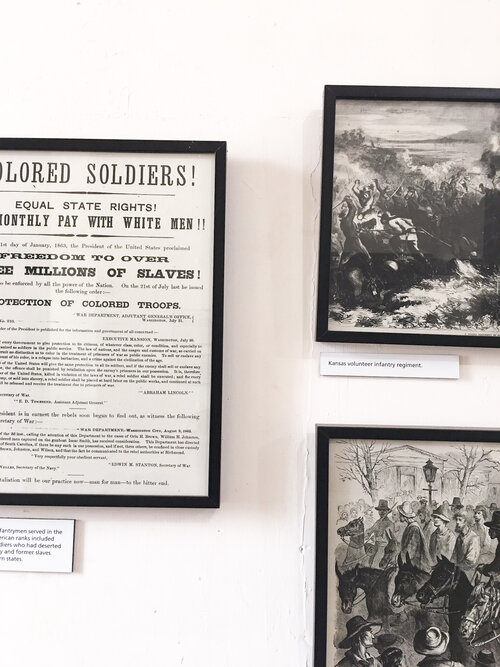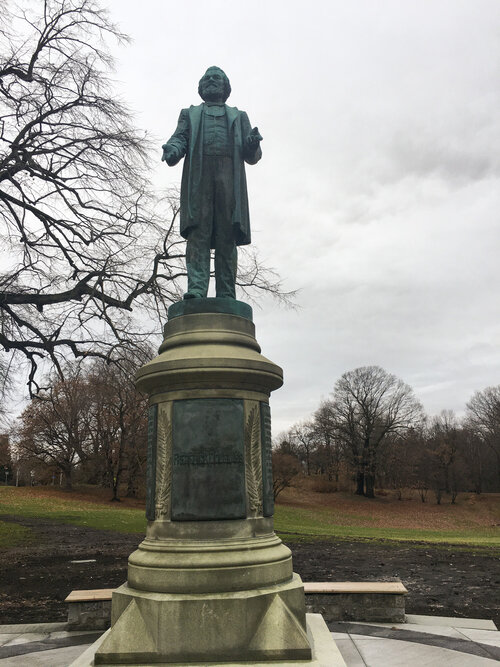Hey girl! This post may contain affiliate links. This means that if you make a purchase through one of them, I will receive a small commission. At no extra cost to you! This helps me to keep my site free and running. I am so incredibly grateful for your support. For more info, check out my Privacy Policy.

Welcome back to another week of black history! Welcome to week three of our black history celebration. In case you didn’t know, every Tuesday this month we’ve been celebrating Black History Month by highlighting all things black travel. Let’s do a little recap, shall we?
The first week we took a look at historical black women who have impacted the way we travel. Last week I took you on a 24-hour journey into America’s Black Mecca. This week we’re gonna take a peek at five less famous spots to celebrate black history.
Sometimes when we think of something as important as black history, we tend to gravitate toward the grandiose and only focus on the more famous attractions. For example, The King Center in Atlanta or The National Museum of African American History and Culture in DC, which is the largest African American museum in the United States—and who wouldn’t?!
These places are extraordinary and even groundbreaking, but there are also lots of places hiding in plain sight that may not be on your radar. In this post, I’ll be sharing 5 lesser-known black history sites to celebrate black history.

Hey Lady! This post is part of a Black History series for 2020. Don’t forget to check out the other posts in the series:
- 4 Trailblazing Black Women Who Rocked the Travel World
- 24 Hours in Black-owned Atlanta: A Celebratory Guide
- 4 Black-owned Etsy Shops to Make Your Travels a Little Sweeter

1. African Burial Ground National Monument (NYC)
Can you imagine finding hundreds and hundreds of African remains? This is exactly what happened in 1991. Lemme start from the top. In Lower Manhattan right by the Financial District, lies the first on my list of black history sites. The African Burial Ground National Monument in New York City is the largest excavated burial ground. It memorializes over 20,000 Africans—which can I add, nearly half were children—you read me right—children. I need a moment of silence for that one.

The burial ground was lost under urban development until 1991 when the site was rediscovered due to the Federal Office Building construction. This was quickly followed by a full-on archeological excavation that was called one of the most important urban archeological undertakings of the century. And that it was. Archeologists discovered the remains of over 400 enslaved and free Africans. And get this…the scope of the burial ground was too large to be fully excavated. So can you imagine how many more remains were left without re-discovery? The story doesn’t stop there though.

Once word got out, critics and activists were concerned that the exposed remains were not being handled properly and with the appropriate care, especially since none of the archaeologists had prior experience investigating the diaspora. Control of the project shifted hands and long story short, African American activists lobbied and pushed to halt construction and have the site demoralized…and they won.
The memorial site is closed from November to March but the visitor center is open year-round from Tuesday to Saturday. For more information, check out their website here.
2. Fort Point at the Presidio of San Francisco
“I’m just a Buffalo Soldier, In the heart of America. Stolen from Africa, brought to America.” If those Bob Marley lyrics give you all the feels, the permanent exhibition on the Buffalo Soldiers at Fort Point is gonna take that to the next level.
The Presidio of San Francisco is a 1500-acre former military post turned FREE National Park. There are hiking trails and because it’s at the foot of the Golden Gate Bride, there are also some dope views. At Fort Point is where you can wander through the Buffalo Soldier exhibition. African Americans fought in wars for years, but it wasn’t until 1866 that they were “legally” allowed to enlist and be forever free. In that time, six all-black calvaries were created and served on the Western frontier. The calvaries were known as the Buffalo Soldiers.


The display at Fort Point walks you through the plight and success of these soldiers from their formation to the desegregation of the military in the mid-50s and beyond. That’s well over 85 years of stories, facts, and pictures to reflect upon.
The cool thing is that some of the Buffalo Soldiers were the first rangers to patrol California’s national parks, which means many of them were stationed right there at the Presidio. And what’s even more is, you can view the graves of over 450 African American soldiers just a short walk away at the San Francisco National Cemetery. The exhibition is free and heart-rendering. Click here for more information.

3. St. Augustine’s Episcopal Church (Oakland, CA)
Oakland is known for being a beautiful city in the Bay, but it’s also home to the Black Panther Party. It was founded in the 60s at Oakland City College. Despite widely held beliefs, the party’s purpose was to patrol and protect the African American community, who were constantly pursued by law enforcement and subject to police brutality.
St. Augustine’s Episcopal Church is one of the most underrated black history sites. It was a safe haven for the party under the spiritual advisement of Reverent Earl A. Neil. They would go all out for their community and this is where they held meetings twice weekly and ran social programs like sickle cell testing, free medical services, and their popular breakfast-for-children program. The organizers consulted a nutritionist to determine what should be included and served up to 20,000 meals a week. Tensions were high and the party put their community’s needs at the forefront. In fact, on April 3rd, 1968 they dodged an attempted raid by the police and on the very next day April 4th, Martin Luther King Jr. was assassinated. For service times and more information about the church, click here.

4. Frederick Douglass Monument (Rochester, NY)
Trying to write about someone as prominent as Frederick Douglass is like trying to figure out why everyone’s metabolism plummets when we get older. There’s really no point. It’s better to let his life and work speak for itself. Although Douglass was often forced to move throughout the country and Europe to avoid prison and spread the message of anti-slavery, Rochester was his adopted home.
It was here where he published his North Star Paper. Here where he remained an Underground Railroad operative. Here rests next to his first wife Anna. And here where his statue stands at one of the most underrated black history sites: The Frederick Douglass Memorial Plaza at Highland Park. It’s the first monument of an African American citizen in the country. On the side of the sculpture, you can read three quotes from some of his most important speeches.

But history continues. His life and legacy are sprinkled all over the city, you can simply take your pick. There are Underground Railroad tours, You can view the Main Street building where he published his North Star Paper, or Kelsey’s Landing, the last stop on the Underground Railroad where Douglass would see others off to Canada.
There’s also Susan B. Anthony Square where the “Let’s Have Tea” statue sits to honor his friendship and work with the famed activist. And finally, at Mount Hope Cemetery is where his grave lies. When you’re there, you’ll notice that he has two different stones because he never knew when he was born. The cemetery is also where slaves would run through to escape to freedom.


5.The Apex Museum (Atlanta, GA)
What do the super soaker water gun, ironing board, ice cream scoop, and mailbox have in common? They were all invented by black people. Last on our list of less-famous black history sites is The Apex Museum. It’s located on one of the most historic streets in Atlanta (Auburn Avenue). The Apex Museum opened over 40 years ago but the mission remains the same: To present the complete perspective of African American history.
The African American Panoramic Experience Museum is the oldest Black History museum in Atlanta. It is devoted to telling untold stories and presenting black history that dates back to before slavery. You’ll hear stories like that of Henry Box Brown, a Virginia slave who shipped himself in a box to Philadelphia to escape slavery. The Apex Museum is interactive and showcases African civilization, black inventors, and you can even see an entire room dedicated to black women in STEM fields. There are also pristine,100-year-old photos of Georgia.
Which site are you most excited to visit. Leave a comment and let me know! Until next time!












No Comments